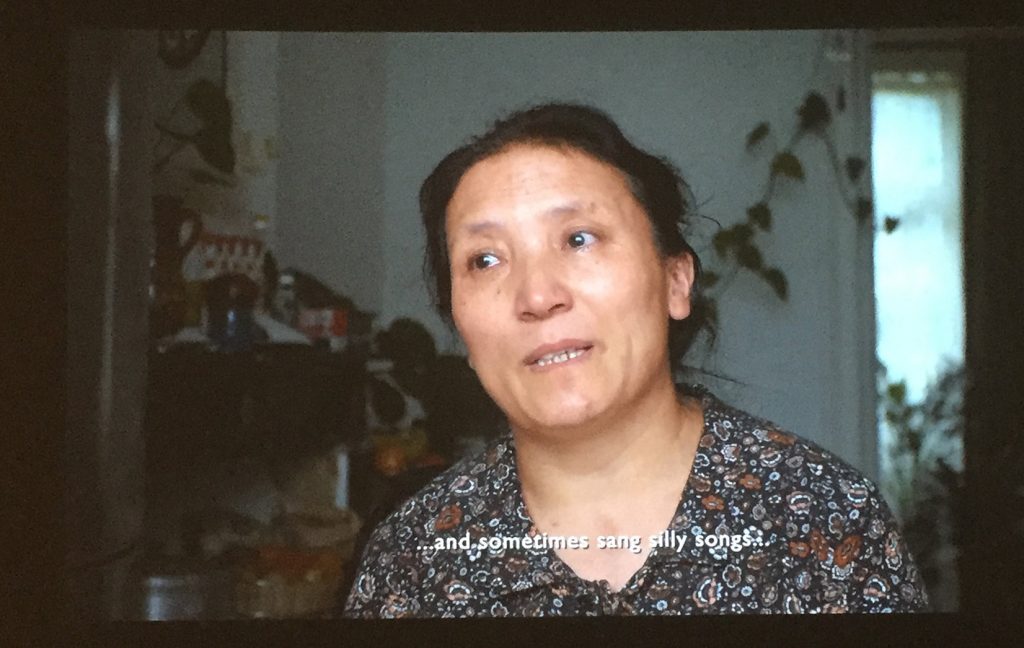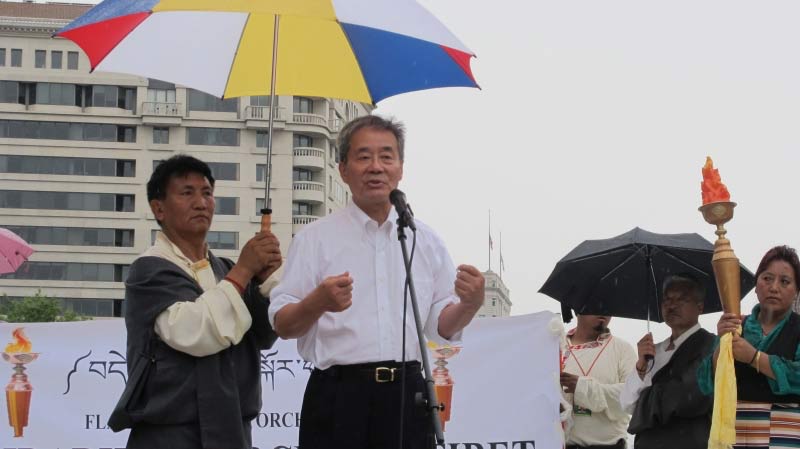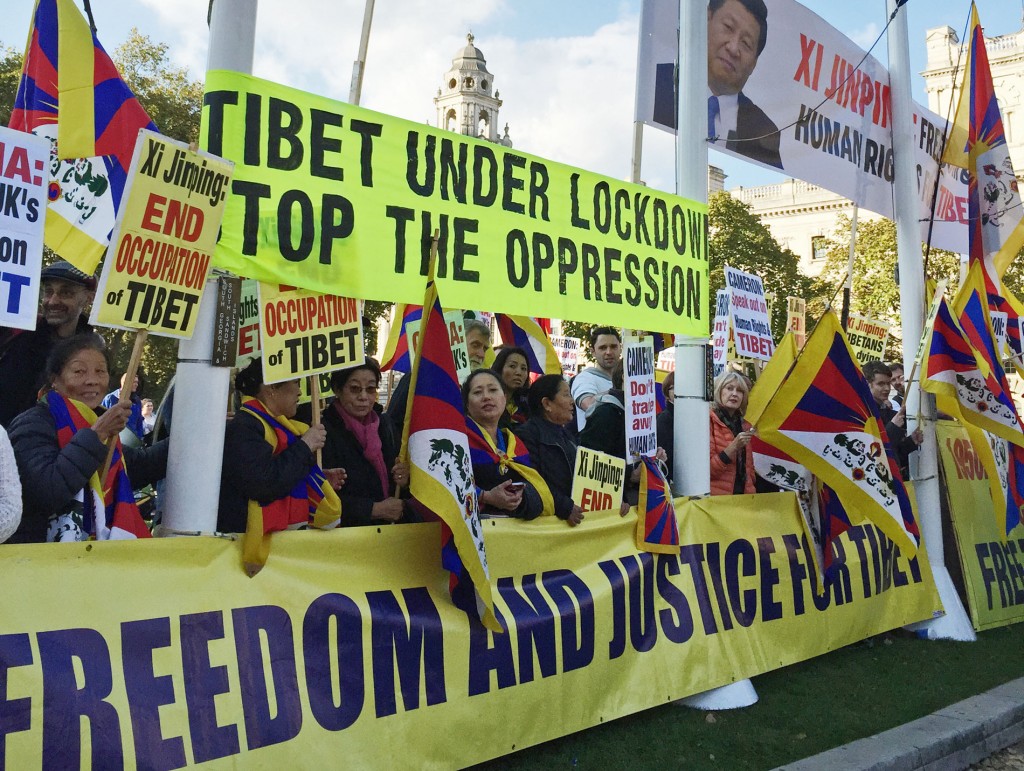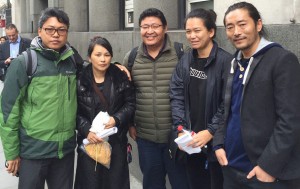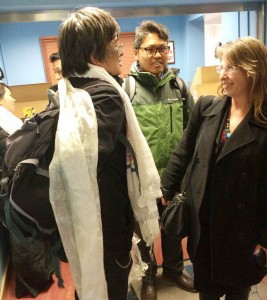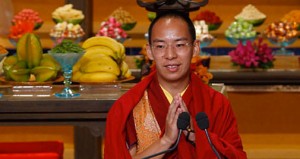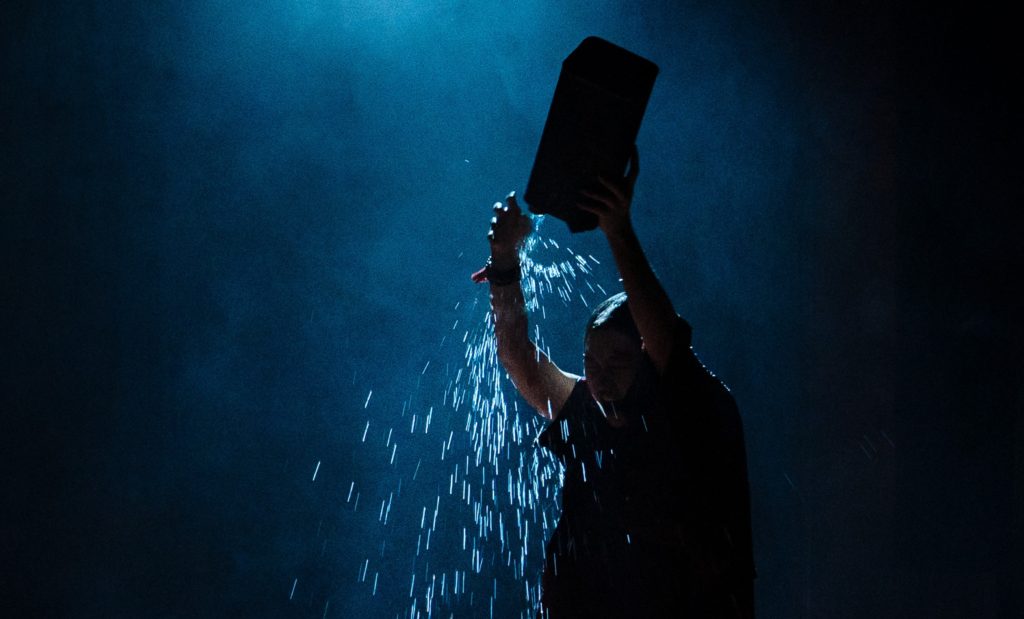
The Tibetan nun Dashar played by Millicent Wong in a scene from Pah-La (Picture: Helen Murray/Royal Court)
Pah-La situates its action in contemporary Tibet in 2008, featuring the self-immolation of a Buddhist nun, staged with the whiff of kerosene and circuit of flames inches from the audience that shoot towards the ceiling before the space is plunged into blackness. Even more shattering, although far less convincing, are the scenes to follow, compelling a London audience to consider the searing reality of what Tibetans have endured since the wave of self-immolations began in 2009 – the incarceration and torture of a nun who survived setting herself on fire, the brutal violence of state oppression, the deeply rooted fears of evisceration of Tibetan Buddhist civilization.
Such representations of Tibetan experience are rare given Beijing’s far-reaching and systematic efforts to silence, subvert and politicize depictions of Tibet that differ from those of the CPC. We are much more familiar with the neuralgic responses of pre-emptive capitulation and self-censorship from Hollywood and in the arts.
In Doctor Strange, for instance a mystical Tibetan guru in Marvel comics’ legend was played by white actress Tilda Swinton as a Celtic sage. Movies in the mould of ‘Seven Years in Tibet’, depicting China’s invasion, and ‘Kundun’, Scorsese’s moving biopic of the Dalai Lama (with a screenplay by the late Melissa Mathison, deeply-missed board member of ICT) are unlikely to appear any time soon. When the creators of ‘Pixels’ wanted to show aliens blasting a hole in the Great Wall of China, Sony executives worried that the scene might prevent the 2015 movie’s release in China, so they blew up the Taj Mahal instead. The new nationalist, assertive mood, in which Hollywood villains cannot be Chinese otherwise they risk jeopardizing the vital Chinese market, was epitomized in the Chinese action movie Wolf Warrior II, which became the highest-grossing Chinese movie of all time. Here, the villain is American, and in the final battle of the film tells Chinese hero Leng, “People like you will always be inferior to people like me. Get used to it.” Leng beats the villain to death and replies, “That was fucking history.” The film closes with the image of a Chinese passport and the words: “Remember, a strong motherland will always have your back!”
Pah-La’s significance in bringing contemporary Tibet to the international stage (first London, other performances will follow) was acknowledged by reviewers; veteran theatre critic Michael Billington welcomed Pah-La’s “attempt to breach the inherent parochialism of British theatre” while Time Out said: “Given that Tibet has steadily drifted out of Western discourse as China’s star has ascended, it feels, above all, important that ‘Pah-La’ exists.”
Rarer still, then, that a writer takes an immersive approach and seeks to follow through ideas and personal testimonies through interviews and a journey into Tibet itself – which Abhishek Mazumdar makes surprisingly public given the dangers to Tibetans this must have entailed, saying that it involved clandestine nocturnal incursions into the two main prisons in Lhasa, Drapchi and Chushur (Qushui). In addition Abhishek – who has tackled contemporary themes of conflict and violence for instance in Kashmir in other plays – has also spoken about receiving threats and harassment from representatives of the Chinese government.
The drama of the play’s creation as depicted in such interviews and public statements would matter less in terms of evaluation of the work if Abhishek had created an entirely fictitious piece with fictitious characters, inspired by Tibet’s recent history. But Abhishek invites us to consider Pah-La as a literal expression, a direct transmission, of his several years of research, interviews and encounters in Tibet and the exile diaspora. And this is why the play has provoked some serious questions for Tibetans and others who have sought to follow closely the unfolding situation in Tibet – particularly since March 2008 transformed the political landscape.
Pah-La is premised on an idea that gathered force for Bengali playwright Abhishek, which is how can Tibetans, who are firmly non-violent, turn violent? In Abhishek’s reading of contemporary history, this is what happened for the first time in March, 2008 (while tangentially referring to a Chushi Gangdruk resistance fighter defecting to the PLA, the play elides the historical context of armed uprisings against Chinese invaders in the 1950s and ‘60s).
In doing so, Pah-La presents a narrative that hews uncomfortably close to that of the Chinese Party state, which depicted the ground-breaking and overwhelmingly peaceful protests of March, 2008 onwards simply as “one violent riot” in Lhasa on March 14 of that year. This narrative gained ground internationally with the “Lhasa riots” still being used as a convenient shorthand to define and therefore misrepresent a wave of several hundred mainly peaceful protests involving nomads, schoolchildren, scholars, monks and nuns that swept across the plateau in the buildup to the 2008 summer Olympics in Beijing. As several Tibetan reviewers point out, the play does not contain even a passing reference to the other protests across the plateau at that time, which continued into 2009, and later. (Review by UK based Tibetans Georgina Choekyi Doji, Tenzin Zega, Dechen Pemba, Kunsang Kelden, and Sonam Anjatsang.)
Yet this period was so significant in Tibet’s contemporary history that it was characterized by one of Tibet’s most important intellectuals, the Amdo writer Tagyal (Shokdung) as: “Tibet’s peaceful revolution…a re-awakening of Tibetan national consciousness and solidarity”.
Abhishek contends – and there is no reason to doubt this – that much more serious violence was perpetrated by Tibetans than has been made public so far, in Lhasa on and after March 14, 2008.The issue is not that these claims are implausible, as they are not, but that Pah-La gives a disproportionate focus on Tibetan violence based on evidence that is not yet in the public domain, and that apparently also ignores the painstaking documentation of what happened in 2008 by Tibetan observers, organizations and international media.
In conversation at the Royal Court in London with Abhishek, he told me that in his depictions of violence by Tibetans he used only the incidents described by Tibetan sources, including the burning of a school and references to rape by Tibetan men. “I would not have used accounts by the Chinese I interviewed, as this would have skewed the picture,” he said. In the Tibetan Review piece – the Tibetan reviewers include Dechen Pemba of High Peaks Pure Earth, who documented and translated Tibetan writings about 2008 and beyond – also point out that the more dominant voices in the play belong to the Chinese characters. Similarly, to critique a scene of sexual assault by a Tibetan man of a Chinese woman – as the same fair and balanced review did – is not to deny that rape by Tibetans did not exist in 2008, it was to make the point that the way it was depicted in Pah-La came across as “strange and inappropriate”.
The three pages of acknowledgements in the script of Pah-La give a disturbing insight into the nature of Abhishek’s research inside Tibet, even while they are obliquely framed. Almost any encounters in today’s Lhasa are unlikely to escape the reach of one of the most dystopian and intrusive police and security states in the world. Before he was transferred as Party chief of the Tibet Autonomous Region to Xinjiang in 2016, soldier-turned-politician Chen Quanguo developed a system combining cutting edge surveillance technology with the deployment of tens of thousands of Party cadres in monasteries, schools, and homes, with the aim of rewiring Tibetan thoughts and beliefs, giving rise to fears of nothing less than obliteration of cultural and religious identity. Abhishek thanks sources for “risking their lives so that the rest of us could hear your stories”. But it is not clear that the real stories of those nuns, or other Tibetans, are being told and given due weight in Pah-La, even despite the genuine insights and at times, one suspects, direct quotes gleaned from his research.
The second act of ‘Pah-La’ in particular seems oddly unmoored from lived Tibetan experience of 2008 and beyond. For example, the dialectical debate between the Chinese prison guard and his captor, Tibetan nun Dashar, centering on a polygraph machine was unconvincing, even while Abhishek’s research on the sale of a number of such machines from Hong Kong to Lhasa after March 2008 is interesting and thought-provoking. (ICT has monitored the use of polygraph or ‘lie-detector’ tests among officials in eastern Tibet, linked to an evaluation of their political loyalty to the CCP. The reports, published in Chinese state media, are evidence of a disturbing new level of intrusion into the private lives and thoughts of Tibetans, indicating the atmosphere of suspicion and paranoia in the official sphere and the CPC’s insecurities over the erosion of its authority.)
Abhishek’s research should not be discounted, but nor should the painstaking documentation of March, 2008 onwards by Tibetans and Tibet organizations, as well as the monitoring of Tibetan self-immolations since Kirti monk Tapey set himself ablaze on February 27, 2009, after a prayer ceremony was cancelled at his monastery. With breathtaking courage, in 2008, Tibetans inside Tibet propelled the issue to the top of the international news agenda prior to the Beijing Olympics in August, China’s ‘coming out party’ on a global stage. (See ICT’s report).
Tibetan writer Tsering Woeser was one of those key voices, with more than 3 million internet users visiting her blog, and daily updates translated into numerous languages. There were so many wrenching stories – the blind monk who committed suicide, the lama who was beaten when he tried to prevent a protest from escalating, the hundreds of monks, hooded, bloody, with bare feet, dragged from Drepung monastery onto the Lhasa train to be taken to camps in remote Qinghai. Thousands of Tibetans were ‘disappeared’, often being taken from their homes in the middle of the night to face extreme brutality in ‘black jails.’ The spike in numbers of political prisoners since March 10, 2008, was the largest increase that has ever occurred in Tibetan areas of the PRC under China’s current Constitution and Criminal Law.
Woeser documented the internal lives and feelings of Tibetans, too, at that time; in one of her poems, ‘Fear in Lhasa’, she described how the fear in the city today is greater than at the time of three key events in Tibet’s contemporary history – the Lhasa Uprising, which led to the Dalai Lama’s escape into exile in March 1959, the Cultural Revolution, and the imposition of martial law in March 1989. She wrote: “A hurried farewell to Lhasa/Where the fear starts at the Potala and strengthens as you go east, through the Tibetans’ quarter/Dreadful footsteps reverberate all round, but in daylight you won’t glimpse even their shadow/They are like demons invisible by day, but the horror is worse, it could drive you mad/ A few times I have passed them and the cold weapons in their hands.”
Referring to the scale and scope of the crackdown that followed the protests, Abhishek says: “You could not believe a regime would turns so mad. There was a sense of madness across the board.” Pah-La points towards an aspect of 2008 that is little known, which is the resignations of Tibetan and Chinese prison guards and police from their jobs due to revulsion at the violence that followed the protests and riots, of which Abhishek appears to have some knowledge. He also hints at a way of viewing the protests through the lens of gender via the character of a female prison guard who blames the chaos on “all the fathers”; the Tibetan men for engaging in violence, the Chinese for responding with such overwhelming brutality.
An equally contentious point in Pah-La has proved to be that the (Tibetan) violence in Lhasa in March 2008 was sparked by the self-immolation of a Tibetan nun. Abhishek explained to me that he had heard the rumour of the self-immolation of a Tibetan nun prior to the March protests in 2008 several times; he later said that one of his sources had seen her name on a prison list. He also contends that there have been many more self-immolations than the 155 documented by ICT and other organisations. (The self-immolation in the play takes place on a remote hillside on a railway track in faraway Kham, with no explanation for why the nun Dashar then appears in a prison cell in Lhasa. There is no railway in Kham, yet, the ‘steel dragon’ traversing the Tibetan plateau that opened in 2006 runs from Qinghai to Lhasa).
According to current information, the wave of self-immolations that have swept across the Tibetan plateau began with the Kirti monk Tapey who set fire to himself on February 27, 2009, after a religious ceremony at his monastery in Amdo (Ngaba) was cancelled. (The first self-immolation in Tibetan society in the modern era took place in exile in Delhi, India, on April 27, 1998, when Thubten Ngodrup set himself on fire – and later died – as a Tibetan Youth Congress hunger strike was broken up by Indian police.)
Tibetans have said that when they hear of a self-immolation, they pray that the individual dies, rather than survive the ordeal that follows. Tapey survived. Monks from Kirti monastery in exile said that police opened fire on him after extinguishing the flames, and that according to further information received three years later (demonstrating the extent of the information blackout), “They are not allowing the bullet wounds on his arms and legs to heal, but repeatedly re-opening them in the name of medical treatment.” The same sources said that when Tapey was taken to hospital after his self-immolation in Barkham the first thing he said to his mother was, “I am not the son you want to see. I should have died that day, but I didn’t manage it.”
An official documentary shown on Chinese TV in 2012 showed Tapey in hospital, wearing monks’ robes, with his head, neck, arms and legs heavily scarred, sitting under a pink quilt emblazoned with the word ‘Love.’ Despite the heavy pressure he must have been under to express his regret, or blame the Dalai Lama, in the video Tapey simply talks carefully only about his physical condition, saying that most parts of his body have physically healed and he can write slowly with one of his hands. The humanity of hospital staff is conveyed through a nurse, speaking to the official news agency Xinhua, who says: “With Tibetan incense, prayer beads and Buddhism sutras laid on his bedside table, Tapey normally spent no less than an hour participating in Buddhist services in both the morning and evening.”
Another monk who self-immolated and is depicted in the same video gives a similar succinct message to camera, omitting any mention of regret and manipulation by “external forces” (despite inevitable pressure to single out the Dalai Lama as being responsible). Eighteen-year old Kirti monk Lobsang Kelsang, who set fire to himself on September 26, 2011, was filmed in his hospital bed saying: “I have no words but thanks – doctors have given me another life, they all treat me well.”
The Party state narrative on March 2008 was immediate and unambiguous. When CCTV made a documentary called “Records of the Lhasa Riots” in 2008, footage of the incidents on March 14, 2008, was broadcast over and over again on primetime television in China, and was made into a DVD. The deaths of Chinese shop workers were broadcast repeatedly on Chinese national television, with little or no mention of the Tibetan shop workers who died in the same fires – and no mention of Tibetans killed when Chinese troops opened fire, or afterwards following torture. (Leading Tibetan historian and scholar Tsering Shakya wrote in the book “The Struggle for Tibet” written with Wang Lixiong that when much larger riots broke out in Wengan, Guizhou and inland China, even Chinese bloggers wondered why the protestors in Lhasa had been demonized on national television as criminals, while in Wengan the local leadership was sacked, an investigation team sent to review local policies, and news of the incident scarcely reported in the official media at all.)
The official response was far more muted and ambiguous when the self-immolations began. It was not until May 2012 –three years after Tapey set fire to himself in 2009 – that the Chinese state media produced its most elaborate response in the form of a video broadcast in both Chinese and English (with some variations between the two) on Chinese Central Television (CCTV), China’s predominant state television broadcaster. The preparation time accorded to the documentary, and a series of articles published a month later which gave more human details about those who had self-immolated, gave a sense of individuals within a bureaucratic system struggling for an adequate and coherent response.
It is still not known exactly how many people were killed or died after torture following the events of March, 2008; the Beijing leadership engaged in a comprehensive cover-up of the torture, disappearances and killings across Tibet combined with a virulent propaganda offensive against the exiled Tibetan leader, Nobel Peace Laureate the Dalai Lama.
Pah-La is a flawed but passionately-felt attempt by the playwright to lead us to a deeper understanding, and it poses serious questions. More answers will come from inside Tibet over time; just as it is only now that we have gained a fuller comprehension of the sheer scale of the killings and oppression in March, 1959, through Jianglin Li’s essential analysis of eyewitness sources and classified government records.
The most powerful scene in Pah-La, for me was entirely without dialogue. Nuns are darting around a dark stage amidst fluttering religious texts, in the gaze of a gleaming Buddha; Buddhist mantras can be heard amid Communist Party slogans. It is a moment when the sheer power and energy of Tibetan culture and individuals seeking to transcend their terror through the transformative impacts of Tibetan Buddhism can be sensed.
At an after-show talk during Pah-La’s run in London Abhishek Mazumdar reflected on his experience meeting a child who later apparently died of starvation in prison, after March 2008. “What sort of play do you write after that? With Tibetans I speak to, there is often a sense of having lived through an experience that is so harsh, it is not that one doesn’t want to talk about it, it is that one doesn’t have the words.”

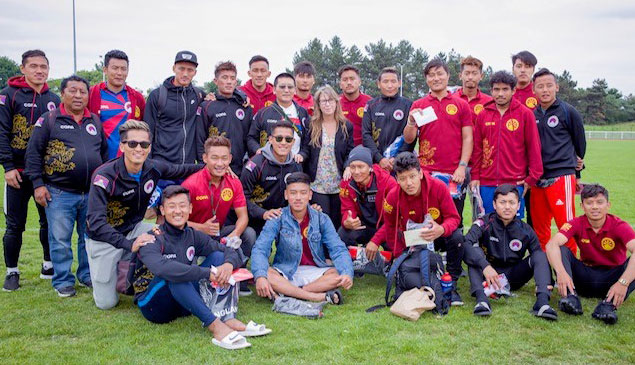
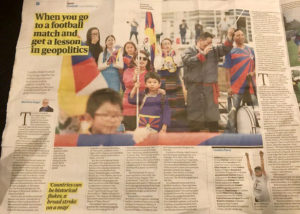
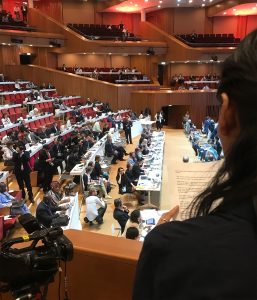
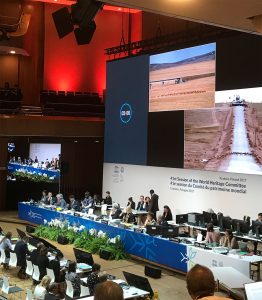
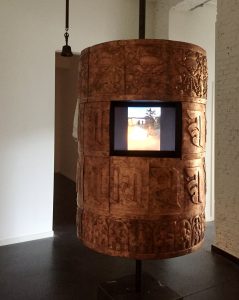
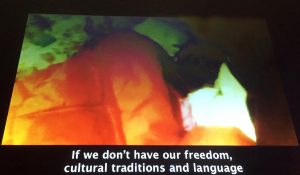 In ‘Two Friends’, a single channel video depicts 22-year old former monk, Ngawang Norphel, blackened almost beyond recognition as a human being, speaking on camera to monks who are tending him after his self-immolation.
In ‘Two Friends’, a single channel video depicts 22-year old former monk, Ngawang Norphel, blackened almost beyond recognition as a human being, speaking on camera to monks who are tending him after his self-immolation.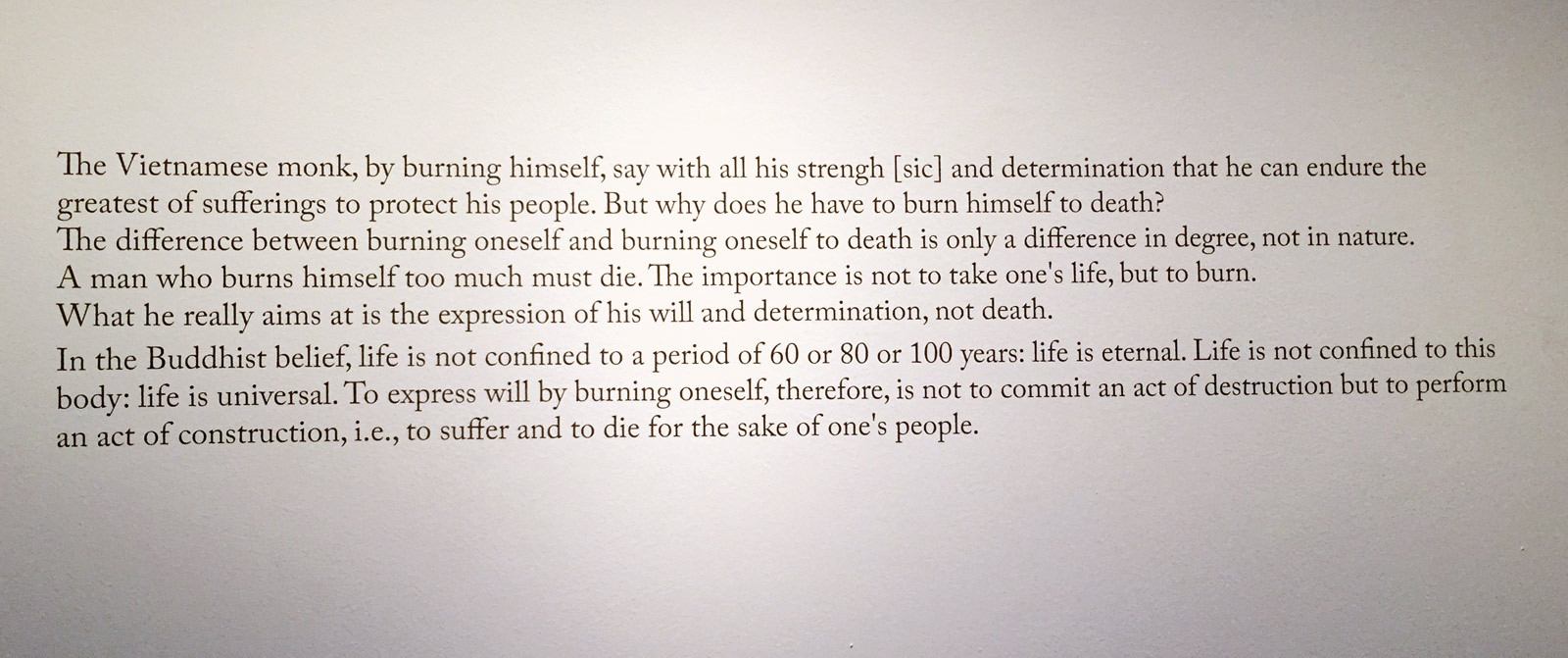
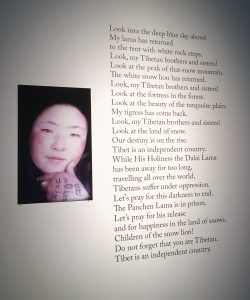 On the wall, lines from a poem left by 17-year old nun Sangye Dolma, whose luminous and beautiful face appears here more as a classical painting than selfie, reveal a message of hope beyond despair. Like many of those who set themselves on fire in Tibet, it is not addressed to the U.N., the international community but to fellow Tibetans, written in solidarity, and urging them to “Look my Tibetan brothers and sisters! Look at the land of the snow. Our destiny is on the rise. […] Children of the snow lion! Do not forget that you are Tibetan. Tibet is an independent country.”
On the wall, lines from a poem left by 17-year old nun Sangye Dolma, whose luminous and beautiful face appears here more as a classical painting than selfie, reveal a message of hope beyond despair. Like many of those who set themselves on fire in Tibet, it is not addressed to the U.N., the international community but to fellow Tibetans, written in solidarity, and urging them to “Look my Tibetan brothers and sisters! Look at the land of the snow. Our destiny is on the rise. […] Children of the snow lion! Do not forget that you are Tibetan. Tibet is an independent country.”